UV Light Irradiation Effects in P-Doped Diamonds: Total Content Determination of Phosphorus Donors
Abstract
1. Introduction
2. Materials and Methods
2.1. Sample Preparation and Characterization
2.2. Spectroscopic Measurements
3. Results and Discussion
3.1. Study of IR Spectra under Laser Irradiation
3.2. Laser Power’s Impact on the Absorption Spectra
3.3. Determination of the Total Concentration of Phosphorus Donors in Diamond
4. Conclusions
Author Contributions
Funding
Institutional Review Board Statement
Informed Consent Statement
Conflicts of Interest
References
- Tsao, J.Y.; Chowdhury, S.; Hollis, M.A.; Jena, D.; Johnson, N.M.; Jones, K.A.; Kaplar, R.J.; Rajan, S.; Van de Walle, C.G.; Bellotti, E.; et al. Ultrawide-Bandgap Semiconductors: Research Opportunities and Challenges. Adv. Electron. Mater. 2018, 4, 1600501. [Google Scholar] [CrossRef]
- Shikata, S. Single crystal diamond wafers for high power electronics. Diam. Relat. Mater. 2016, 65, 168–175. [Google Scholar] [CrossRef]
- Collins, A.T.; Williams, A.W.S. The nature of the acceptor centre in semiconducting diamond. J. Phys. C Solid State Phys. 1971, 4, 1789–1800. [Google Scholar] [CrossRef]
- Kim, H.; Vogelgesang, R.; Ramdas, A.K.; Rodriguez, S.; Grimsditch, H.; Anthony, T.R. Electronic Raman and infrared spectra of isotopically controlled “blue” diamonds. Phys. Rev. B 1998, 57, 15315. [Google Scholar] [CrossRef]
- Blank, V.D.; Kuznetsov, M.S.; Nosukhin, S.A.; Terentiev, S.A.; Denisov, V.N. The influence of crystallization and boron concentration in growth environment on its distribution in growth sectors of type IIb diamond. Diam. Relat. Mater. 2007, 16, 800–804. [Google Scholar] [CrossRef]
- Polyakov, S.N.; Denisov, V.N.; Mavrin, B.N.; Kirichenko, A.N.; Kuznetsov, M.S.; Martyushov, S.Y.; Terentiev, S.A.; Blank, V.D. Formation of boron-carbon nanosheets and bilayers in boron-doped diamond: Origin of metallicity and superconductivity. Nanoscale Res. Lett. 2016, 11, 11–20. [Google Scholar] [CrossRef]
- Akaishi, M.; Kanda, H.; Yamaoka, S. Phosphorus: An elemental catalyst for diamond synthesis and growth. Science 1993, 259, 1592. [Google Scholar] [CrossRef]
- Palyanov, Y.N.; Kupriyanov, I.N.; Sokol, A.G.; Khokhryakov, A.F.; Borzdov, Y.M. Diamond Crystallization from a Sulfur−Carbon System at HPHT Conditions. Cryst. Growth Des. 2011, 11, 2599. [Google Scholar] [CrossRef]
- Blank, V.D.; Boldyrev, K.N.; Denisov, V.N.; Denisov, V.V.; Galkin, A.S.; Kuznetsov, M.S.; Mavrin, B.N.; Nosukhin, S.A.; Prikhodko, D.D.; Sukhanov, A.A.; et al. Electronic band structure of phosphorus-doped single crystal diamond: Dynamic Jahn-Teller distortion of the tetrahedral donor ground state. Phys. Rev. B 2020, 102, 115153. [Google Scholar] [CrossRef]
- Kamo, M.; Sato, Y.; Matsumoto, S.; Setaka, N. Diamond synthesis from gas phase in microwave plasma. J. Cryst. Growth 1983, 62, 642–644. [Google Scholar] [CrossRef]
- Achard, J.; Issaoui, R.; Tallaire, A.; Silva, F.; Barjon, J.; Jomard, F.; Gicquel, A. Freestanding CVD boron doped diamond single crystals: A substrate for vertical power electronic devices? Phys. Status Solidi 2012, 209, 1651–1658. [Google Scholar] [CrossRef]
- Bogdanov, S.A.; Vikharev, A.L.; Drozdov, M.N.; Radishev, D.B. Synthesis of thick and high-quality homoepitaxial diamond with high boron doping level: Oxygen effect. Diam. Relat. Mater. 2017, 74, 59–64. [Google Scholar] [CrossRef]
- Alexenko, A.E.; Spitsyn, B.V. Semiconducting diamonds made in the USSR. Diam. Relat. Mater. 1992, 1, 705–709. [Google Scholar] [CrossRef]
- Koizumi, S.; Kamo, M.; Sato, Y.; Ozaki, H.; Inuzuka, T. Growth and characterization of phosphorous doped {111} homoepitaxial diamond thin films. Appl. Phys. Lett. 1997, 71, 1065–1067. [Google Scholar] [CrossRef]
- Sternschulte, H.; Thonke, K.; Sauer, R.; Koizumi, S. Optical evidence for 630-meV phosphorus donor in synthetic diamond. Phys. Rev. B 1999, 59, 12924. [Google Scholar] [CrossRef]
- Pinault-Thaury, M.-A.; Temgoua, S.; Gillet, R.; Bensalah, H.; Stenger, I.; Jomard, F.; Issaoui, R.; Barjon, J. Phosphorus-doped (113) CVD diamond: A breakthrough towards bipolar diamond devices. Appl. Phys. Lett. 2019, 114, 11210. [Google Scholar] [CrossRef]
- Abubakr, E.; Abdelrahman, Z.; Ohmagari, S.; Katamune, Y.; Ikenoue, H.; Yoshitake, T. Laser-Induced Phosphorus-Doped Conductive Layer Formation on Single-Crystal Diamond Surfaces. ACS Appl. Mater. Interfaces 2020, 12, 57619–57626. [Google Scholar] [CrossRef]
- Stenger, I.; Pinault-Thaury, M.-A.; Temahuki, N.; Gillet, R.; Temgoua, S.; Bensalah, H.; Chikoidze, E.; Dumont, Y.; Barjon, J. Electron mobility in (100) homoepitaxial layers of phosphorus-doped diamond. J. Appl. Phys. 2021, 129, 105701. [Google Scholar] [CrossRef]
- Pinault-Thaury, M.-A.; Stenger, I.; Gillet, R.; Temgoua, S.; Chikoidze, E.; Dumont, Y.; Jomard, F.; Kociniewski, T.; Barjon, J. Attractive electron mobility in (113) n-type phosphorus-doped homoepitaxial diamond. Carbon 2021, 175, 254. [Google Scholar] [CrossRef]
- Matsuoka, M.; Tsuchida, Y.; Ohtani, N.; Yamada, T.; Koizumi, S.; Shikata, S. Polarized Raman spectroscopy of phosphorous doped diamond films. Diam. Relat. Mater. 2021, 114, 108283. [Google Scholar] [CrossRef]
- Araujo, D.; Suzuki, M.; Lioret, F.; Alba, G.; Villar, P. Diamond for Electronics: Materials, Processing and Devices. Materials 2021, 14, 7081. [Google Scholar] [CrossRef] [PubMed]
- Bormashov, V.S.; Tarelkin, S.A.; Buga, S.G.; Volkov, A.P.; Golovanov, A.V.; Kuznetsov, M.S.; Kornilov, N.V.; Teteruk, D.V.; Luparev, N.V.; Terent’ev, S.A.; et al. Electrical Properties of High-Quality Synthetic Boron-Doped Diamond Single Crystals and Schottky Barrier Diodes on Their Basis. Inorg. Mater. 2018, 54, 1469–1476. [Google Scholar] [CrossRef]
- Grotjohn, T.A.; Trana, D.T.; Yaranb, M.K.; Demlow, S.N.; Schuelke, T. Heavy phosphorus doping by epitaxial growth on the (111) diamond surface. Diam. Relat. Mater. 2014, 44, 129. [Google Scholar] [CrossRef]
- Stenger, I.; Pinault-Thaury, M.-A.; Lusson, A.; Kociniewski, T.; Jomard, F.; Chevallier, J.; Barjon, J. Quantitative analysis of electronic absorption of phosphorus donors in diamond. Diam. Relat. Mater. 2017, 74, 24–30. [Google Scholar] [CrossRef]
- Nebel, C.E. Bulk electronic properties of diamond. arXiv 2020, arXiv:2005.03884. [Google Scholar]
- Kato, H.; Takeuchi, D.; Tokuda, N.; Umezawa, H.; Okushi, H.; Yamasaki, S. Characterization of specific contact resistance on heavily phosphorus-doped diamond films. Diam. Relat. Mater. 2009, 18, 782. [Google Scholar] [CrossRef]
- Barjon, J.; Pinault, M.A.; Kociniewski, T.; Jomard, F.; Chevallier, J. Cathodoluminescence as a tool to determine the phosphorus concentration in diamond. Phys. Status Solidi A 2007, 204, 2965–2970. [Google Scholar] [CrossRef]
- Blank, V.D.; Denisov, V.N.; Kirichenko, A.N.; Kurnetsov, M.S.; Mavrin, B.N.; Nosukhin, S.A.; Terentiev, S.A. Raman scattering by defect-induced excitations in boron-doped diamond single crystals. Diam. Relat. Mater. 2008, 17, 1840–1843. [Google Scholar] [CrossRef]
- White, J.J. Effects of external and internal electric fields on the boron acceptor states in silicon. Can. J. Phys. 1967, 45, 2695–2718. [Google Scholar] [CrossRef]
- Kolbesen, B.O. Simultaneous determination of the total content of boron and phosphorus in high-resistivity silicon by IR spectroscopy at low temperatures. Appl. Phys. Lett. 1975, 27, 353–355. [Google Scholar] [CrossRef]
- Baber, S.C. Net and total shallow impurity analysis of silicon by low temperature fourier transform infrared spectroscopy. Thin Solid Films 1980, 72, 201–210. [Google Scholar] [CrossRef]
- Boldyrev, K.N.; Boldyrev, N.Y.; Kirillin, R.V. Device for Measuring Doping Impurities of Groups III and V in High-Purity Silicon by Long-Wavelength Spectroscopy. Bull. Russ. Acad. Sci. Phys. 2013, 77, 1420–1424. [Google Scholar] [CrossRef]

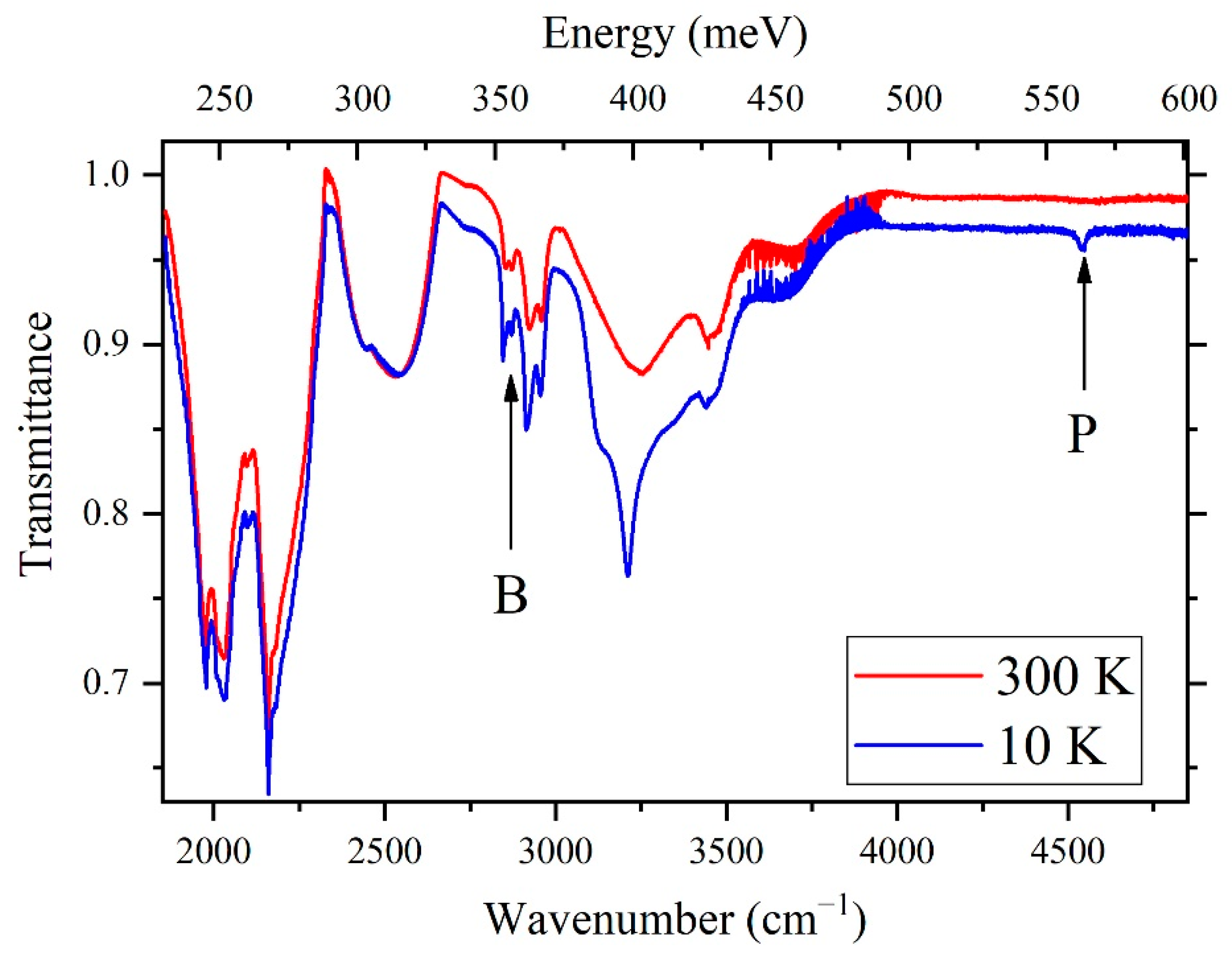
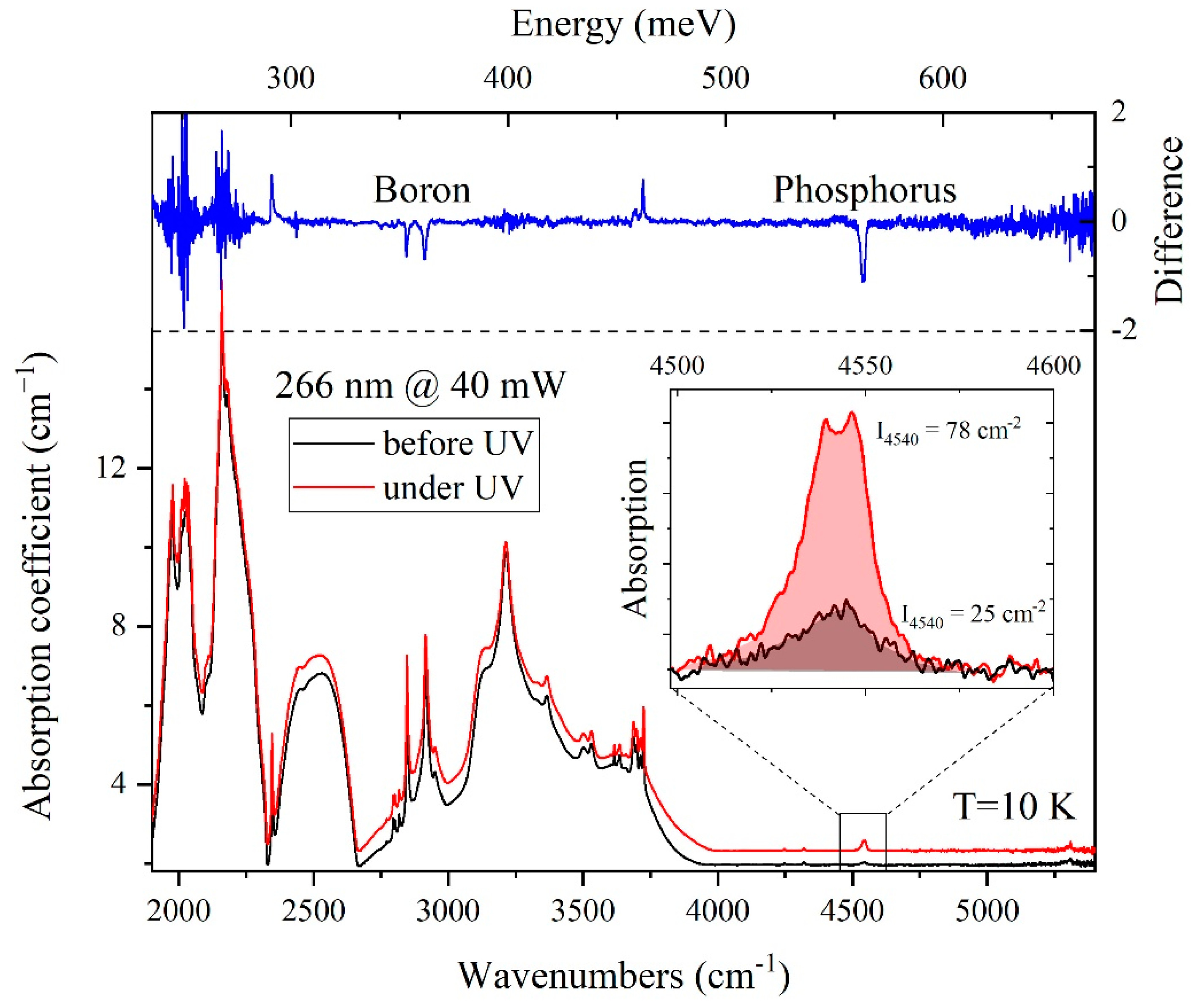
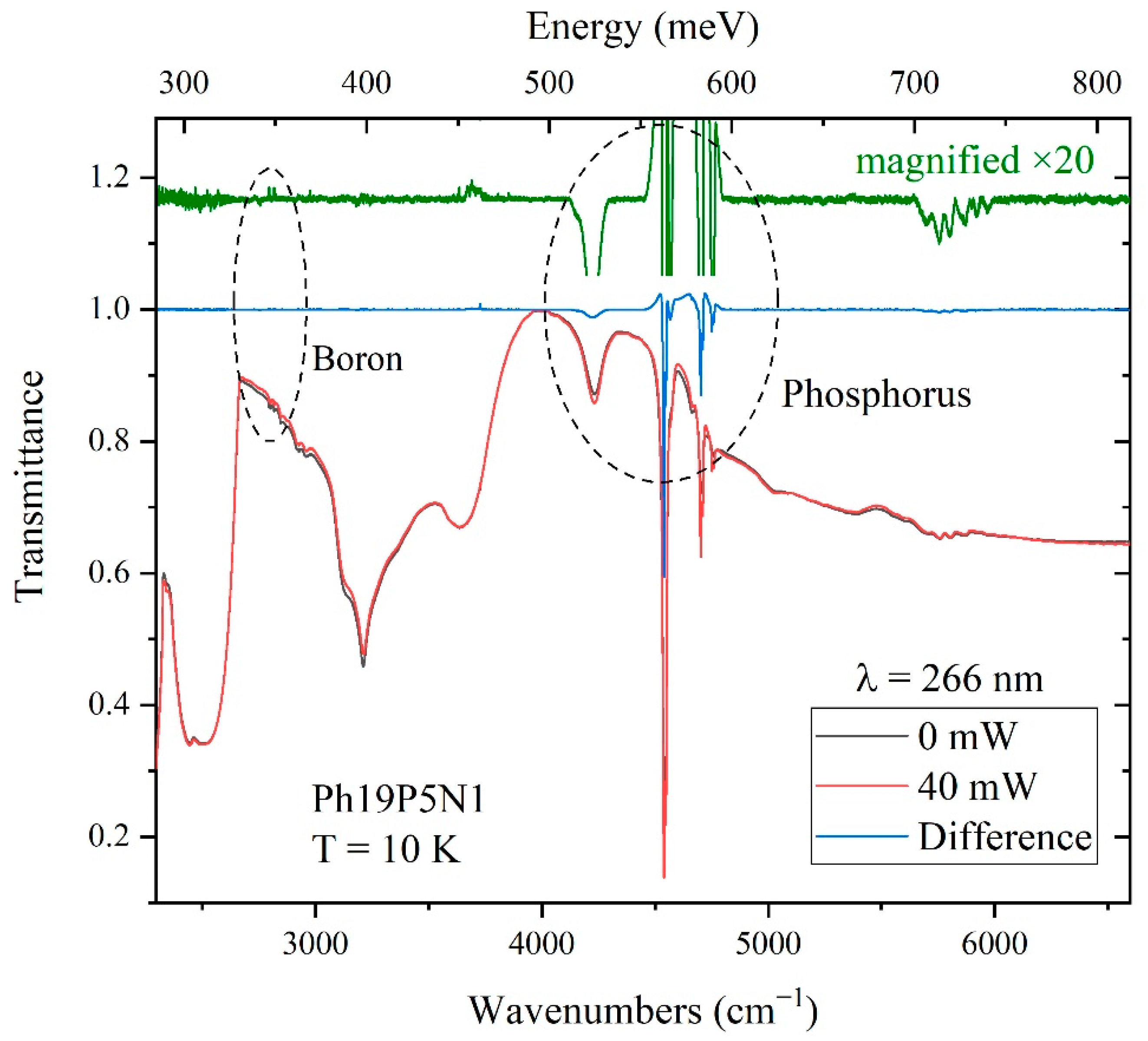
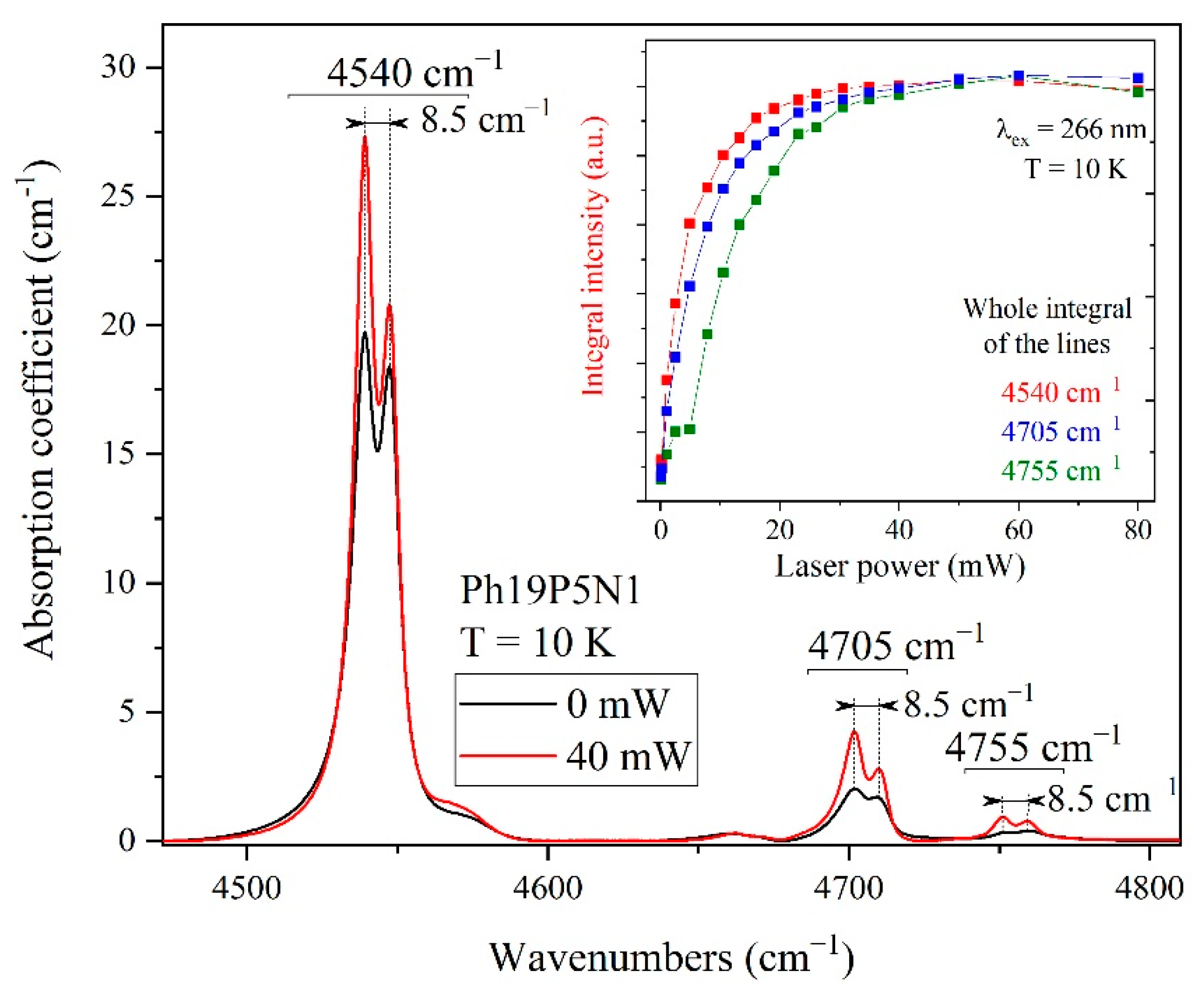
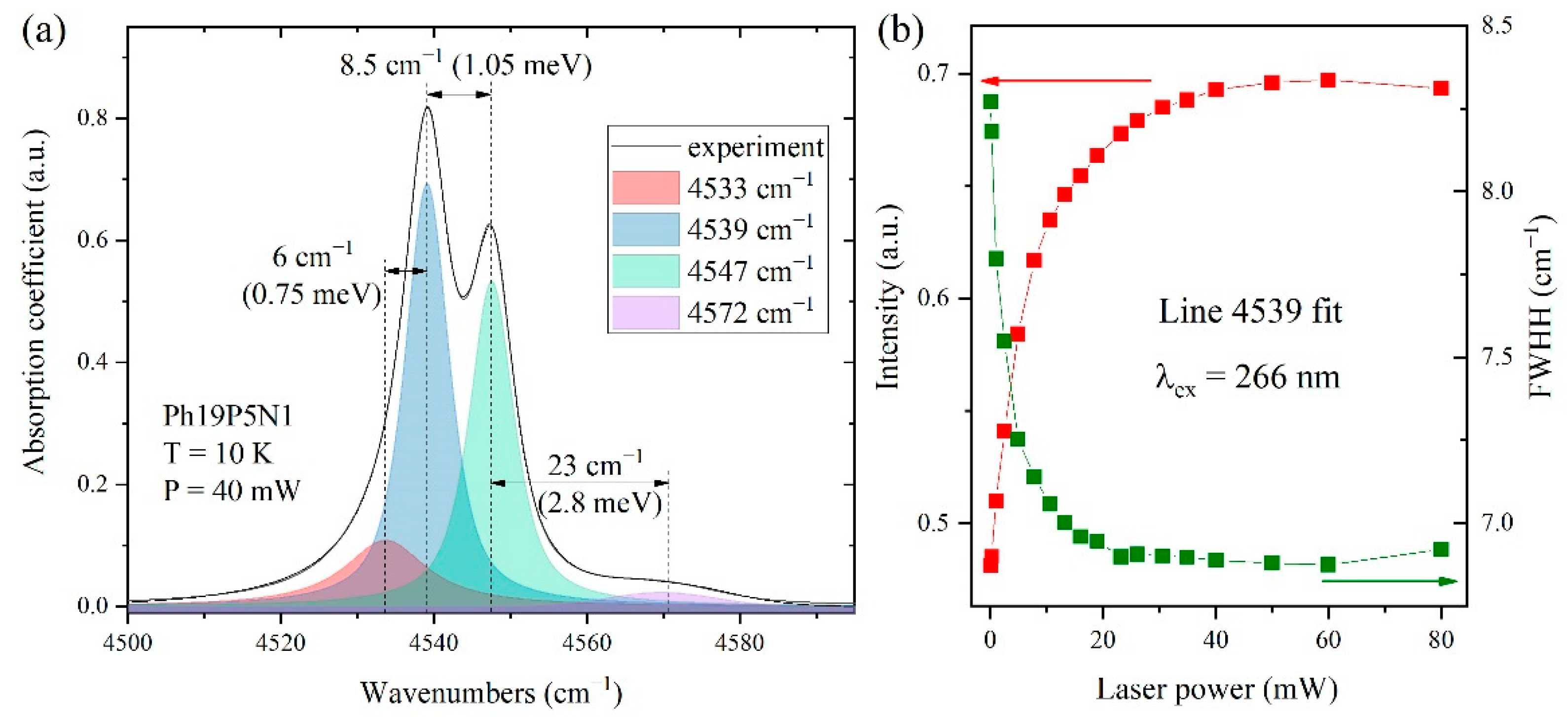
| SAMPLE | ND (cm−3) | I4540 (cm−2) | I4540@UV (cm−2) | ND-NA (cm−3) | ND_tot (cm−3) | ND_comp (cm−3) | k (%) |
|---|---|---|---|---|---|---|---|
| Ph14N2 | 2 × 1016 | 25 ± 5 | 78 ± 5 | 6.7 × 1015 | 2.1 × 1016 | 1.4 × 1016 | 68 |
| Ph19P5N1 | 1.1 × 1017 | 353 ± 5 | 407 ± 5 | 0.95 × 1017 | 1.1 × 1017 | 1.5 × 1016 | 13 |
Publisher’s Note: MDPI stays neutral with regard to jurisdictional claims in published maps and institutional affiliations. |
© 2022 by the authors. Licensee MDPI, Basel, Switzerland. This article is an open access article distributed under the terms and conditions of the Creative Commons Attribution (CC BY) license (https://creativecommons.org/licenses/by/4.0/).
Share and Cite
Boldyrev, K.; Klimin, S.; Denisov, V.; Tarelkin, S.; Kuznetsov, M.; Terentiev, S.; Blank, V. UV Light Irradiation Effects in P-Doped Diamonds: Total Content Determination of Phosphorus Donors. Materials 2022, 15, 9048. https://doi.org/10.3390/ma15249048
Boldyrev K, Klimin S, Denisov V, Tarelkin S, Kuznetsov M, Terentiev S, Blank V. UV Light Irradiation Effects in P-Doped Diamonds: Total Content Determination of Phosphorus Donors. Materials. 2022; 15(24):9048. https://doi.org/10.3390/ma15249048
Chicago/Turabian StyleBoldyrev, Kirill, Sergey Klimin, Viktor Denisov, Sergey Tarelkin, Mikhail Kuznetsov, Sergey Terentiev, and Vladimir Blank. 2022. "UV Light Irradiation Effects in P-Doped Diamonds: Total Content Determination of Phosphorus Donors" Materials 15, no. 24: 9048. https://doi.org/10.3390/ma15249048
APA StyleBoldyrev, K., Klimin, S., Denisov, V., Tarelkin, S., Kuznetsov, M., Terentiev, S., & Blank, V. (2022). UV Light Irradiation Effects in P-Doped Diamonds: Total Content Determination of Phosphorus Donors. Materials, 15(24), 9048. https://doi.org/10.3390/ma15249048






